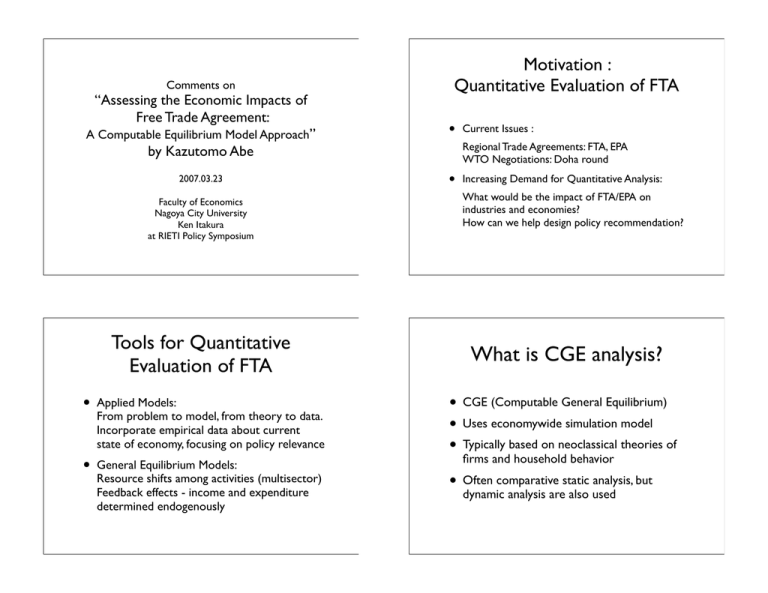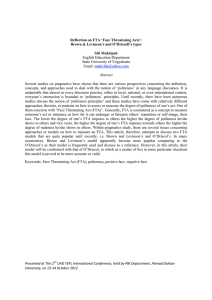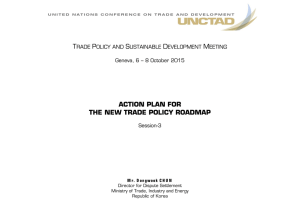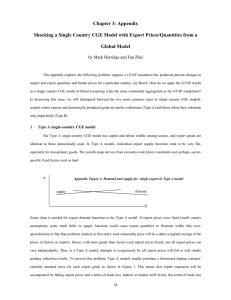•
advertisement

Comments on “Assessing the Economic Impacts of Free Trade Agreement: A Computable Equilibrium Model Approach” Motivation : Quantitative Evaluation of FTA • Regional Trade Agreements: FTA, EPA WTO Negotiations: Doha round by Kazutomo Abe 2007.03.23 Faculty of Economics Nagoya City University Ken Itakura at RIETI Policy Symposium Tools for Quantitative Evaluation of FTA • Applied Models: From problem to model, from theory to data. Incorporate empirical data about current state of economy, focusing on policy relevance • General Equilibrium Models: Resource shifts among activities (multisector) Feedback effects - income and expenditure determined endogenously Current Issues : • Increasing Demand for Quantitative Analysis: What would be the impact of FTA/EPA on industries and economies? How can we help design policy recommendation? What is CGE analysis? • CGE (Computable General Equilibrium) • Uses economywide simulation model • Typically based on neoclassical theories of firms and household behavior • Often comparative static analysis, but dynamic analysis are also used https://www.gtap.agecon.purdue.edu/ What is GTAP • Global Trade Analysis Project at Center for Global Trade Analysis, Purdue Univ. • Publicly funded project, based in academia supporting a global economic data base and Computable General Equilibrium (CGE) model which are: • • • fully documented publicly available accessible to non-modelers Version 6 GTAP Database • Coverage considerably expanded: 87 regions and 57 sectors (65 regions and 57 sectors in version 5) • Corresponding to the global economy in 2001 • Improved domestic data base, government consumption, income taxes, service trade, domestic support, and elasticity estimates. GTAP Models • Core Model (Hertel 1997): Relatively standard, multi-region GE model PC/CRTS production Armington treatment of import demands Global transport sector supplies margins • Current Model: gtap.tab version6.2 www.gtap.agecon.purdue.edu/models/current.asp “Replication” ASEAN10+6 FTA Sim. GTAP Models (cont.) • Extensions: Investment dynamics Productivity linkages Energy and environment Income distribution for poverty analysis Labor migration • Regional FTA : ASEAN, Japan, China, Korea, Australia, New Zealand, India • Complete removal of tariffs and export subsidies in the region • Comparative static simulation Accumulation Effect of FTA Summary • CGE model analyses can be utilized for quantitative evaluation of FTA. • Francois et.al. (1996) “Liberalization and Capital Accumulation in the GTAP Model,” GTAP Technical Paper No. 7 • • Comparative static simulation captures increase in investment because of FTA, but capital stock stays same level. Transparency of data and model facilitate communications between policy makers and economists • Francois et.al. incorporate a link between investment and capital stock into the GTAP model. CGE models need to keep up with theoretical development. • More work should be done to address the current concerns: Rule of Origin, Fragmentation of production etc. •




